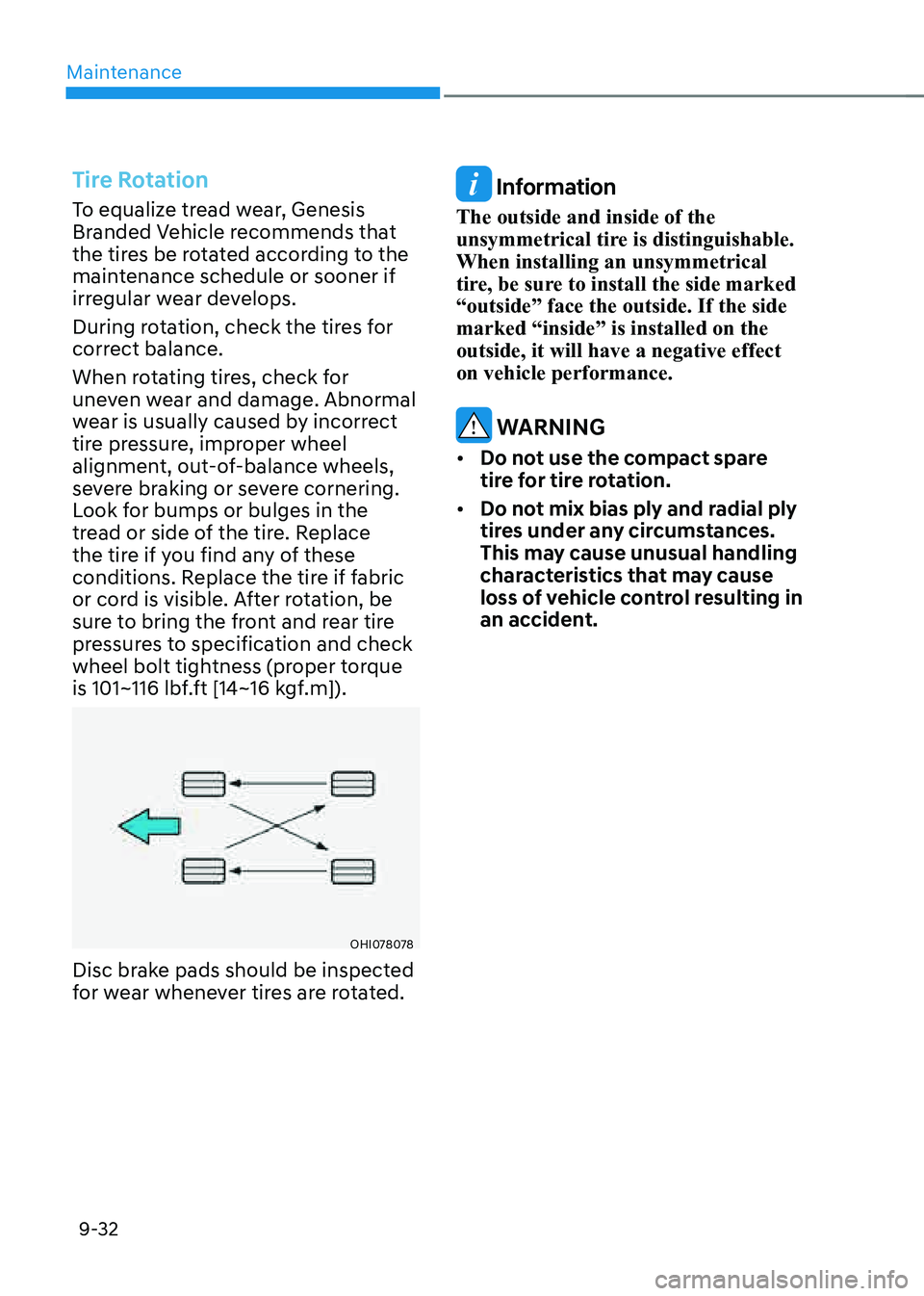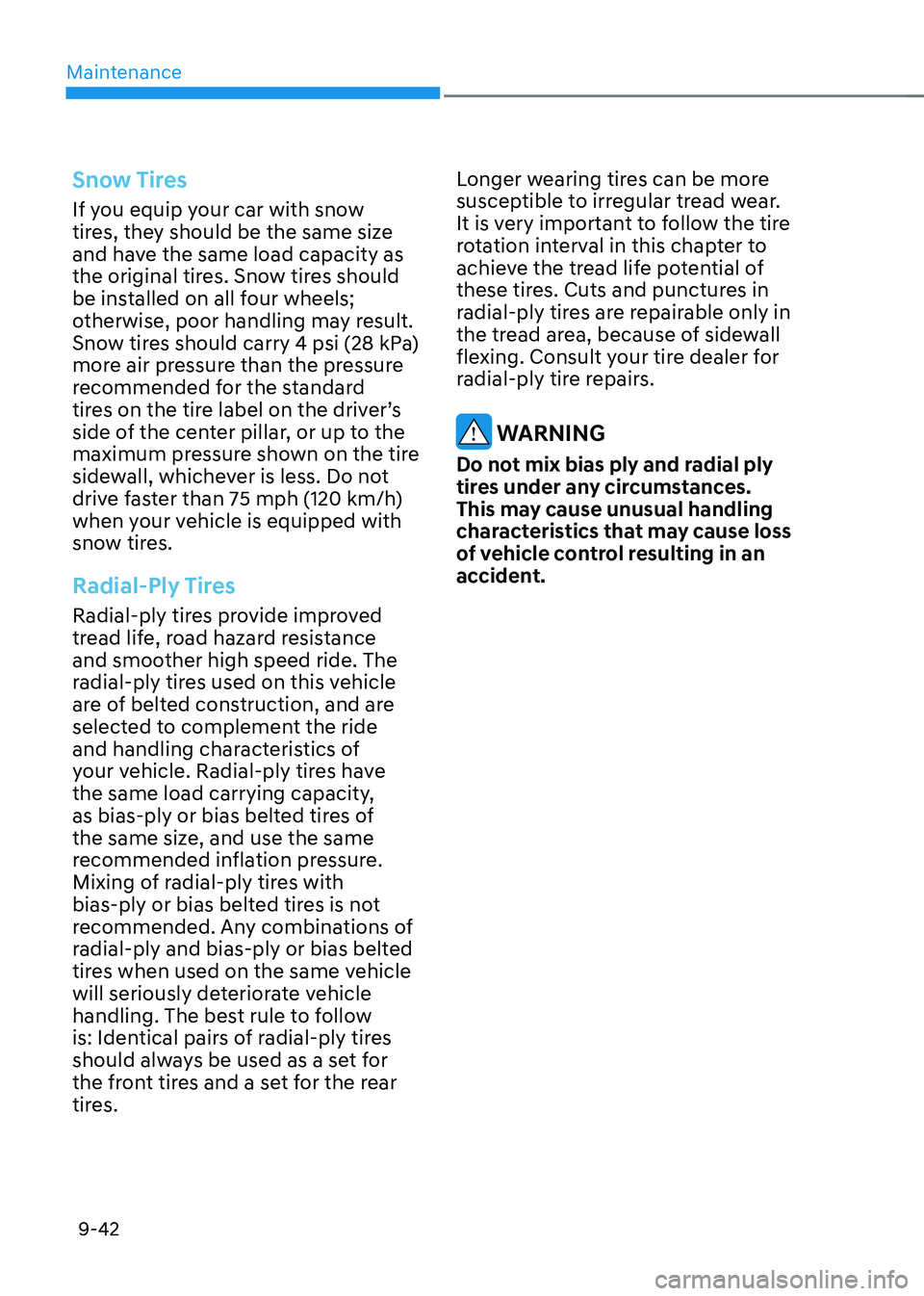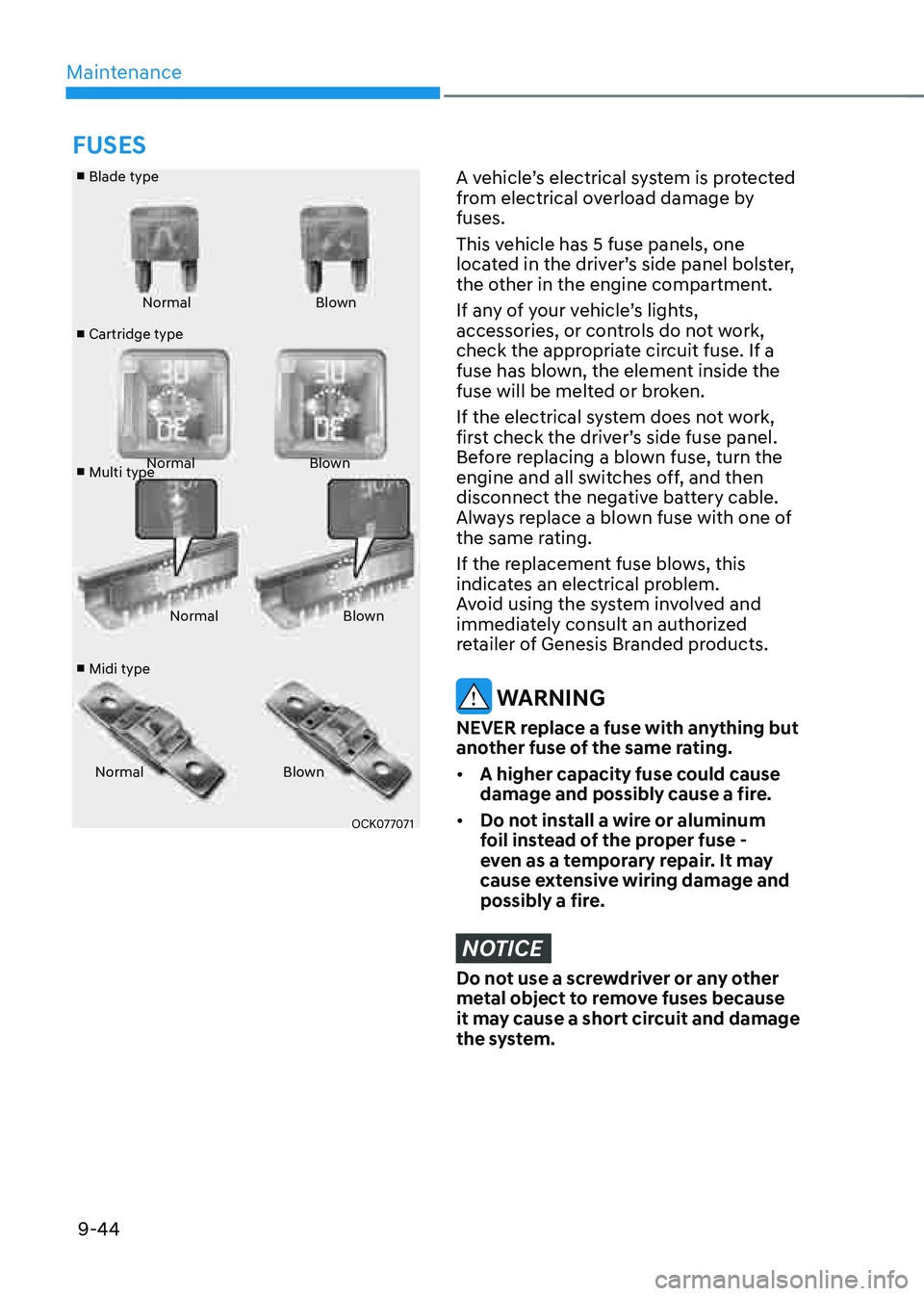maintenance GENESIS GV80 2021 Service Manual
[x] Cancel search | Manufacturer: GENESIS, Model Year: 2021, Model line: GV80, Model: GENESIS GV80 2021Pages: 632, PDF Size: 9.37 MB
Page 573 of 632

Maintenance
9-32
Tire Rotation
To equalize tread wear, Genesis
Branded Vehicle recommends that
the tires be rotated according to the
maintenance schedule or sooner if
irregular wear develops.
During rotation, check the tires for
correct balance.
When rotating tires, check for
uneven wear and damage. Abnormal
wear is usually caused by incorrect
tire pressure, improper wheel
alignment, out-of-balance wheels,
severe braking or severe cornering.
Look for bumps or bulges in the
tread or side of the tire. Replace
the tire if you find any of these
conditions. Replace the tire if fabric
or cord is visible. After rotation, be
sure to bring the front and rear tire
pressures to specification and check
wheel bolt tightness (proper torque
is 101~116 lbf.ft [14~16 kgf.m]).
OHI078078OHI078078
Disc brake pads should be inspected
for wear whenever tires are rotated.
Information
The outside and inside of the
unsymmetrical tire is distinguishable.
When installing an unsymmetrical
tire, be sure to install the side marked
“outside” face the outside. If the side
marked “inside” is installed on the
outside, it will have a negative effect
on vehicle performance.
WARNING
• Do not use the compact spare
tire for tire rotation.
• Do not mix bias ply and radial ply
tires under any circumstances.
This may cause unusual handling
characteristics that may cause
loss of vehicle control resulting in
an accident.
Page 575 of 632

Maintenance
9-34
Compact spare tire replacement
(if equipped)
A compact spare tire has a shorter
tread life than a regular size tire.
Replace it when you can see the
tread wear indicator bars on the tire.
The replacement compact spare tire
should be the same size and design
tire as the one provided with your
new vehicle and should be mounted
on the same compact spare tire
wheel. The compact spare tire is
not designed to be mounted on a
regular size wheel, and the compact
spare tire wheel is not designed for
mounting a regular size tire.
WARNING
The original tire should be repaired
or replaced as soon as possible to
avoid failure of the compact spare
tire and loss of vehicle control
resulting in an accident. The
compact spare tire is for emergency
use only. Do not operate your
vehicle over 50 mph (80 km/h)
when using the compact spare tire.
Wheel Replacement
When replacing the metal wheels
for any reason, make sure the new
wheels are equivalent to the original
factory units in diameter, rim width
and offset.
Tire Traction
Tire traction can be reduced if you
drive on worn tires, tires that are
improperly inflated or on slippery
road surfaces. Tires should be
replaced when tread wear indicators
appear. To reduce the possibility of
losing control, slow down whenever
there is rain, snow or ice on the road.
Tire Maintenance
In addition to proper inflation,
correct wheel alignment helps to
decrease tire wear. If you find a tire
is worn unevenly, have your dealer
check the wheel alignment.
When you have new tires installed,
make sure they are balanced. This
will increase vehicle ride comfort
and tire life. Additionally, a tire
should always be rebalanced if it is
removed from the wheel.
Page 577 of 632

Maintenance
9-36
Tire speed ratings
The chart below lists many of the
different speed ratings currently
being used for passenger vehicle
tires. The speed rating is part of the
tire size designation on the sidewall
of the tire. This symbol corresponds
to that tire’s designed maximum safe
operating speed.
Speed Rating Symbol Maximum Speed
S 112 mph (180 km/h)
T 118 mph (190 km/h)
H 130 mph (210 km/h)
V 149 mph (240 km/h)
W 168 mph (270 km/h)
Y 186 mph (300 km/h)
3. Checking tire life (TIN : Tire
Identification Number)
Any tires that are over six years old,
based on the manufacturing date,
(including the spare tire) should be
replaced by new ones. You can find
the manufacturing date on the tire
sidewall (possibly on the inside of
the wheel), displaying the DOT Code.
The DOT Code is a series of numbers
on a tire consisting of numbers and
English letters. The manufacturing
date is designated by the last four
digits (characters) of the DOT code. DOT : XXXX XXXX OOOO
The front part of the DOT shows a
plant code number, tire size and tread
pattern and the last four numbers
indicate week and year manufactured.
For example:
DOT XXXX XXXX 1520 represents that
the tire was produced in the 15th
week of 2020.
4. Genesis exclusive tire
Genesis Branded Vehicle
recommends that tires designed
specifically for Genesis vehicles
be used. You may find the marking
“GOE” (Genesis Original Equipment)
embossed on the tire sidewall.
5. Tire ply composition and material
The number of layers or plies of
rubber-coated fabric in the tire. Tire
manufacturers also must indicate the
materials in the tire, which include
steel, nylon, polyester, and others.
The letter “R” means radial ply
construction; the letter “D“ means
diagonal or bias ply construction;
and the letter “B” means belted-bias
ply construction.
Page 579 of 632

Maintenance
9-38
Temperature - A, B & C
The temperature grades are A (the
highest), B and C representing the
tire’s resistance to the generation
of heat and its ability to dissipate
heat when tested under controlled
conditions on a specified indoor
laboratory test wheel.
Sustained high temperature can
cause the material of the tire to
degenerate and reduce tire life,
and excessive temperature can
lead to sudden tire failure. Grades
B and A represent higher levels of
performance on the laboratory test
wheel than the minimum required
by law.
WARNING
The temperature grade for this tire is
established for a tire that is properly
inflated and not overloaded.
Excessive speed, under-inflation,
over-inflation, or excessive loading,
either separately or in combination,
can cause heat build-up and
possible sudden tire failure. This
may cause loss of vehicle control
resulting in an accident.
Tire Terminology and Definitions
Air pressure
The amount of air inside the tire
pressing outward on the tire. Air
pressure is expressed in pounds per
square inch (psi) or kilopascal (kPa).
Accessory weight
This means the combined weight
of optional accessories. Some
examples of optional accessories
are automatic transmission, power
seats, and air conditioning.
Aspect ratio
The relationship of a tire’s height to
its width.
Belt
A rubber coated layer of cords that
is located between the plies and the
tread. Cords may be made from steel
or other reinforcing materials.
Bead
The tire bead contains steel wires
wrapped by steel cords that hold the
tire onto the rim.
Page 581 of 632

Maintenance
9-40
Maximum loaded vehicle weight
The sum of curb weight; accessory
weight; vehicle capacity weight; and
production options weight.
Normal occupant weight
The number of occupants a vehicle
is designed to seat multiplied by 150
pounds (68 kg).
Occupant distribution
Designated seating positions.
Outward facing sidewall
An asymmetrical tire has a particular
side that faces outward when
mounted on a vehicle. The outward
facing sidewall bears white lettering
or bears manufacturer, brand, and/or
model name molding that is higher
or deeper than the same moldings
on the inner facing sidewall.
Passenger (P-Metric) tire
A tire used on passenger cars
and some light duty trucks and
multipurpose vehicles.
Ply
A layer of rubber-coated parallel
cords.Pneumatic tire
A mechanical device made of rubber,
chemicals, fabric and steel or other
materials, that, when mounted on
an automotive wheel provides the
traction and contains the gas or fluid
that sustains the load.
Pneumatic options weight
The combined weight of installed
regular production options weighing
over 5 lb. (2.3 kg) in excess of the
standard items which they replace,
not previously considered in
curb weight or accessory weight,
including heavy duty breaks, ride
levelers, roof rack, heavy duty
battery, and special trim.
Recommended inflation pressure
Vehicle manufacturer’s
recommended tire inflation pressure
as shown on the tire placard.
Radial ply tire
A pneumatic tire in which the ply
cords that extend to the beads are
laid at 90 degrees to the centerline
of the tread.
Rim
A metal support for a tire and upon
which the tire beads are seated.
Sidewall
The portion of a tire between the
tread and the bead.
Speed rating
An alphanumeric code assigned to a
tire indicating the maximum speed
at which a tire can operate.
Page 583 of 632

Maintenance
9-42
Snow Tires
If you equip your car with snow
tires, they should be the same size
and have the same load capacity as
the original tires. Snow tires should
be installed on all four wheels;
otherwise, poor handling may result.
Snow tires should carry 4 psi (28 kPa)
more air pressure than the pressure
recommended for the standard
tires on the tire label on the driver’s
side of the center pillar, or up to the
maximum pressure shown on the tire
sidewall, whichever is less. Do not
drive faster than 75 mph (120 km/h)
when your vehicle is equipped with
snow tires.
Radial-Ply Tires
Radial-ply tires provide improved
tread life, road hazard resistance
and smoother high speed ride. The
radial-ply tires used on this vehicle
are of belted construction, and are
selected to complement the ride
and handling characteristics of
your vehicle. Radial-ply tires have
the same load carrying capacity,
as bias-ply or bias belted tires of
the same size, and use the same
recommended inflation pressure.
Mixing of radial-ply tires with
bias-ply or bias belted tires is not
recommended. Any combinations of
radial-ply and bias-ply or bias belted
tires when used on the same vehicle
will seriously deteriorate vehicle
handling. The best rule to follow
is: Identical pairs of radial-ply tires
should always be used as a set for
the front tires and a set for the rear
tires.Longer wearing tires can be more
susceptible to irregular tread wear.
It is very important to follow the tire
rotation interval in this chapter to
achieve the tread life potential of
these tires. Cuts and punctures in
radial-ply tires are repairable only in
the tread area, because of sidewall
flexing. Consult your tire dealer for
radial-ply tire repairs.
WARNING
Do not mix bias ply and radial ply
tires under any circumstances.
This may cause unusual handling
characteristics that may cause loss
of vehicle control resulting in an
accident.
Page 585 of 632

Maintenance
9-44
■ Blade type
■ Cartridge type
■ Multi type
■ Midi type Normal
Blown
Normal Blown
Normal Blown
Normal Blown
OCK077071OCK077071
A vehicle’s electrical system is protected
from electrical overload damage by
fuses.
This vehicle has 5 fuse panels, one
located in the driver’s side panel bolster,
the other in the engine compartment.
If any of your vehicle’s lights,
accessories, or controls do not work,
check the appropriate circuit fuse. If a
fuse has blown, the element inside the
fuse will be melted or broken.
If the electrical system does not work,
first check the driver’s side fuse panel.
Before replacing a blown fuse, turn the
engine and all switches off, and then
disconnect the negative battery cable.
Always replace a blown fuse with one of
the same rating.
If the replacement fuse blows, this
indicates an electrical problem.
Avoid using the system involved and
immediately consult an authorized
retailer of Genesis Branded products.
WARNING
NEVER replace a fuse with anything but
another fuse of the same rating.
• A higher capacity fuse could cause
damage and possibly cause a fire.
• Do not install a wire or aluminum
foil instead of the proper fuse -
even as a temporary repair. It may
cause extensive wiring damage and
possibly a fire.
NOTICE
Do not use a screwdriver or any other
metal object to remove fuses because
it may cause a short circuit and damage
the system.
FUSES
Page 587 of 632

Maintenance
9-46
Engine Compartment Panel Fuse
Replacement
Blade fuse / Cartridge fuse
�
Page 589 of 632

Maintenance
9-48
Instrument panel fuse panel
Fuse NameFuse
Rating Circuit Protected
MODULE9 10AOverhead Console Lamp, AMP, Driver Power Seat Module,
Low DC-DC Converter (AMP), 2ND Seat LH/RH Module,
Passenger Power Seat Module, Electro Chromic Mirror, 2ND
Air Ventilation Seat LH/RH Control Module, 2ND Seat LH/
RH Warmer Control Module, Front A/C Controller, Smart
Phone Wireless Charger, Rear A/C Control Panel, Data Link
Connector, Low DC-DC Converter, A/V & Navigation Head
Unit, Front A/C Control Module
INVERTER 30A
AC Inverter
TRAILER 30A
Trailer Controller
MODULE11 10AHead Lamp LH/RH, Multifunction Switch, AC Inverter, ADAS
Unit (Parking),AC Inverter Outlet, Rear Junction Block (Rear
Wiper Relay)
REAR A/C 10A
Rear A/C Control Panel, Rear Blower Motor
MODULE12 10A
IAU, IBU
A/C4 10AE/R SUB Junction Block (Blower Relay), Incar Temperature
Sensor, Front A/C Control Module, Rear A/C Control Panel,
Front A/C Controller
A/BAG IND 10A
Instrument Cluster, Overhead Console Lamp
E-SHIFTER2 10A
Electronic ATM Shift Lever Dial
SPARE(IG2) 15A
Not Used
MODULE10 10A
ICU Junction Block (ESU)
MODULE7 10ADriver Door Module, IBU, Multifunction Switch, IAU, Stop
Lamp Switch
MULTI MEDIA1 25ALow DC-DC Converter (with ISG), A/V & Navigation Head Unit
(without ISG)
MULTI MEDIA2 10AHead-Up Display, Instrument Cluster, Security Indicator, Front
A/C Control Module, Front A/C Controller, Rain Sensor, Rear
Occupant Alert (ROA) Sensor, Rear A/C Control Panel, Power
Tail Gate Unit, Driver/Passenger Power Outside Mirror, Rear
Door Curtain Module, Driver Power Seat Switch, Driver Power
Seat Module, Driver Lumbar Support Unit
CLUSTER 10A
Instrument Cluster, Head-Up Display
IBU2 10A
IBU
Page 591 of 632

Maintenance
9-50
Instrument panel fuse panel
Fuse NameFuse
Rating Circuit Protected
SUN ROOF1 25A
Sunroof Control Unit (Master)
P/SEAT DRV1 25A
Driver Power Seat Module
ECS 15A
ECS Unit
POWER
HANDLE 15A
Steering Tilt & Telescopic Unit
P/DOOR RH 15A
Passenger Door Latch, Rear Door Latch RH
IBU1 10A
IAU, IBU, BLE Unit, Driver/Passenger Door Outside Handle
POWER
OUTLET2 20A
Front Console Power Outlet
P/SEAT DRV2 25A
Driver Power Seat Module
P/SEAT PASS1 25A
Passenger Power Seat Module
S/HEATER DRV 15A
Driver Power Seat Module
S/HEATER PASS 15A
Passenger Power Seat Module
DOOR LOCK 20A
Door Lock/Unlock Relay, Two Turn Unlock Relay
SPARE(B+) 10A
Not Used
MODULE6 10AArmrest Lamp, IBU, Low DC-DC Converter, Electronic ATM
Shift Lever Dial, Front Tray Lamp, Front Console Keyboard,
A/V & Navigation Head Unit, Rear USB Charger, ADAS Unit
(Parking), AMP, IAU, Low DC-DC Converter (AMP)
BRAKE
SWITCH 10A
Stop Lamp Switch, IBU